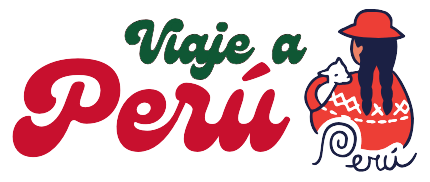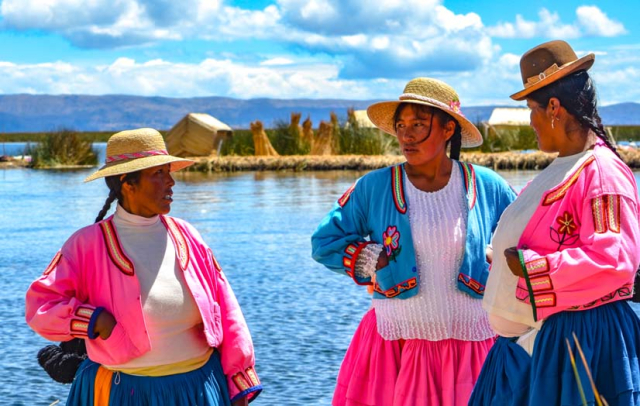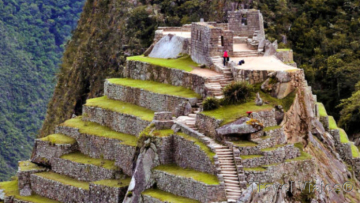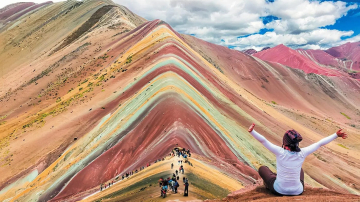Peru is a country known for its cultural diversity and deep connection to ancestral traditions. Peru's indigenous communities preserve practices, languages, and customs that have endured for generations, offering travelers the opportunity to immerse themselves in the authenticity of their way of life. Through respectful visits, it is possible to learn about their relationship with nature, their beliefs, and their art. In this blog, we will explore some of the indigenous communities you can visit in Peru to get a closer look at their rich culture.
1. Uros Community on Lake Titicaca
Located on Lake Titicaca, the Uros community is famous for living on floating islands built with totora , a local aquatic plant . This community keeps alive the traditions of their ancestors, who decided to inhabit these islands to protect themselves from conflicts with other cultures . By visiting them, you can learn about their construction methods , their artisanal fishing and acquire beautiful traditional textiles and crafts.
Additionally , the Uros are known for their hospitality . Visitors can even spend a night on one of their islands, experiencing the tranquility of the lake and learning firsthand about their unique lifestyle and relationship with nature .
2. Awajún people in the Peruvian Amazon
The Awajún are one of the largest indigenous Amazonian communities in Peru , living primarily in the Amazonas and Loreto regions . This community is known for their ability to adapt to the jungle and their deep knowledge of medicinal plants . During a visit, you can take part in guided walks through the jungle to learn about their natural environment and hear stories about their spiritual beliefs and myths related to nature.
For the Awajún , the jungle is not only their home, but a sacred space filled with spirits and energy . The experience allows travelers to understand the respect they have for the environment and the importance of sustainability to preserve their way of life.
3. The Q'ero: The Last Descendants of the Incas
The Q'ero community, located in the mountains of Cusco , is considered one of the last direct descendants of the Incas. The Q'ero preserve many of the traditions and Quechua language of their ancestors . Visiting this community is a spiritual experience, where travelers can participate in Andean ceremonies of gratitude to Pachamama (Mother Earth) and learn about the worldview of the Andes.
The Q'ero are also known for their traditional textiles , full of symbolism, which represent their knowledge and beliefs. Knowing their way of life in the high mountains offers a special connection with the history and spirituality of the Peruvian Andes.
4. Shipibo-Konibo Community in Ucayali
The Shipibo-Konibo, located in the Ucayali region , are famous for their textile art and their knowledge of natural medicine. Their geometric patterns are known as "kené" and represent their connection with the spiritual world and nature. During a visit, you can learn about the meaning of these designs and explore their worldview through traditional ceremonies and conversations with their wise men and healers.
The Shipibo-Konibo also offer art workshops and healing sessions with medicinal plants , allowing visitors to live an immersive and authentic experience in the Amazon rainforest .
5. Taquile Community on Lake Titicaca
On the island of Taquile , in Lake Titicaca , the inhabitants maintain a system of community life , where everything is shared and decisions are made in assembly. The men of the island are known for their weaving skills , a tradition that is passed down from generation to generation . The Taquile textiles , considered Intangible Cultural Heritage of Humanity by UNESCO , are full of symbolism and represent important events in their lives.
Travelers can stay in homestays, where they will learn about daily life on the island, participating in farming and fishing activities, and sharing traditional meals.
6. The Asháninka in the Central Jungle
The Asháninka community is one of the largest in the Amazon and lives mainly in the Junín region. They are known for their deep knowledge of the jungle's flora and fauna , and their ability to adapt to life in this environment. During a visit to the community, travelers can participate in traditional fishing activities , walk through the jungle, and learn about the medicinal plants that the Asháninka use to cure various illnesses.
In addition , the Asháninka practice a way of life that reflects their respect for the forest , and they consider it their role to protect it from external threats. This experience allows visitors to learn about their worldview and their symbiotic relationship with nature.
7. Huilloc Community in the Sacred Valley of the Incas
The Huilloc community , near Ollantaytambo in the Sacred Valley , offers visitors the chance to experience traditional Andean life . The Huilloc are known for their skills in agriculture and textile making, and many of their members still wear vibrantly colored traditional clothing. During your visit, you can take part in agricultural activities, such as potato harvesting , and learn about the collective labor system, or "ayni," that they practice.
The Huilloc consider their land and resources to be sacred, and their culture is strongly linked to Inca traditions . The experience is an immersion in the Andean lifestyle and community values.
Visiting Peru’s indigenous communities allows travelers to connect with an essential part of the country’s history and culture, through authentic and respectful experiences . These communities not only open their doors, but also their hearts, to share their ancestral wisdom, beliefs, and practices. Exploring these places is a way to enrich the trip to Peru , taking visitors to a deeper level of understanding and respect for the cultures that have shaped this country.
We invite you to learn more about Peru here: Blogs from Peru.




